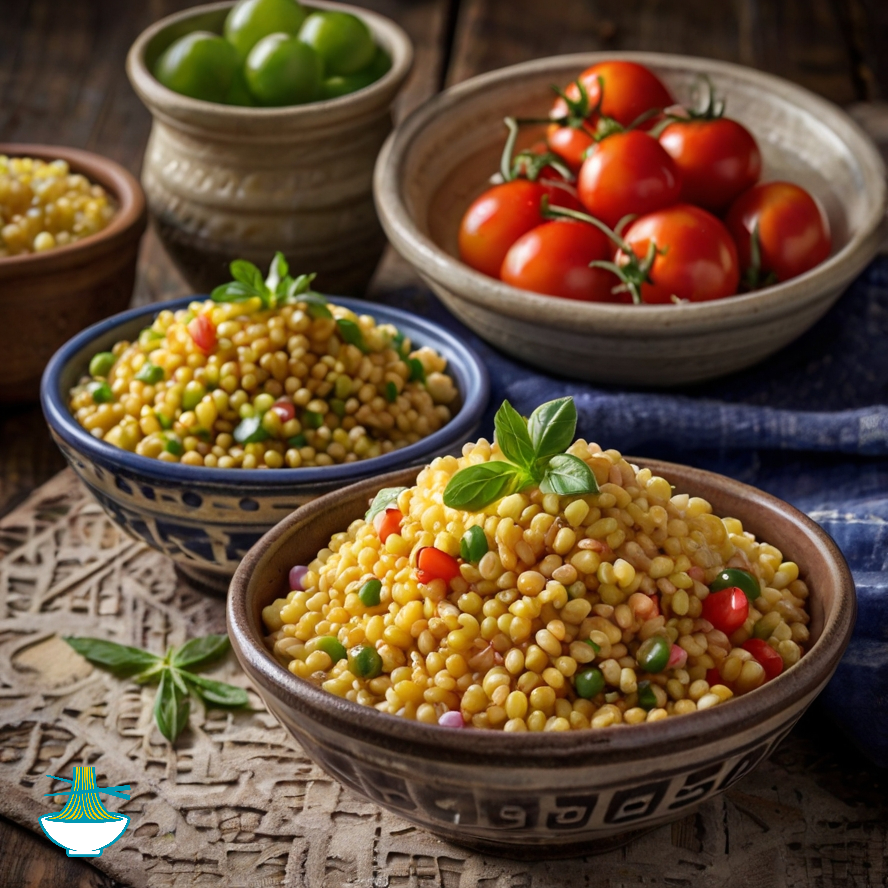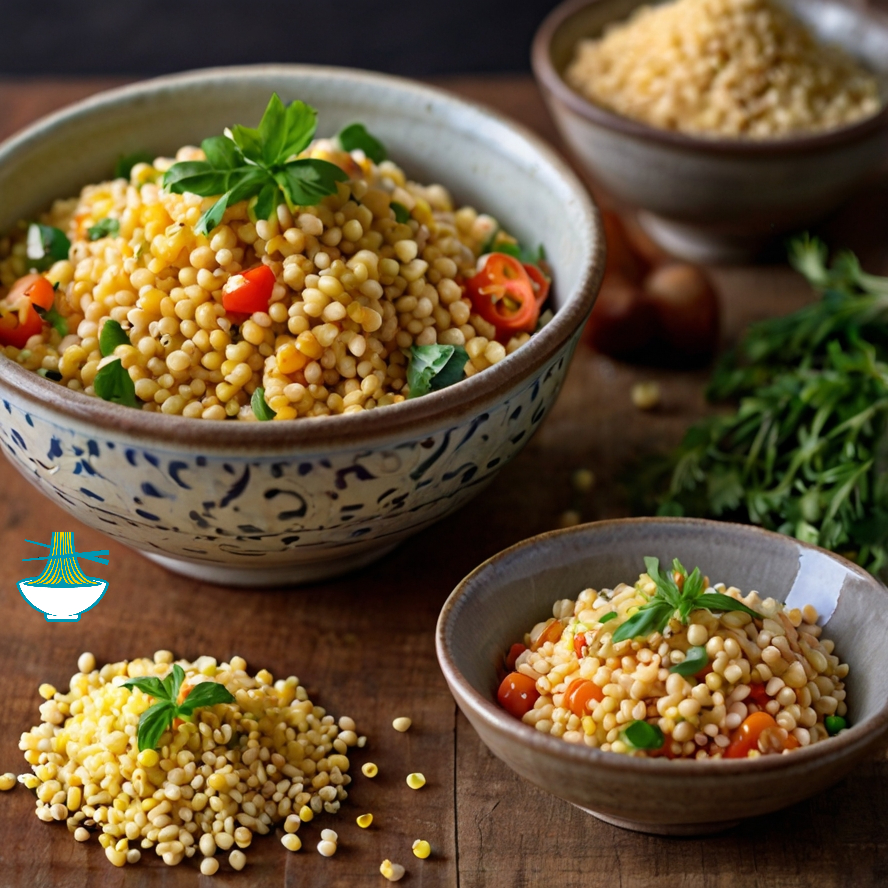Dive into the culinary treasure of Israel with Israeli Couscous, a delightful variety of toasted semolina pasta cherished for its versatile larger pearls. Explore its origins, cultural significance, and the myriad ways it elevates salads and side dishes, bringing a taste of Israeli tradition to your table. Join us on a journey through recipes, preparation tips, and the unique texture that makes Israeli Couscous a beloved ingredient in kitchens around the globe.
Israeli couscous, also known as pearl couscous or ptitim, offers a delightful texture and versatility that pairs well with a variety of ingredients. Here's a simple yet flavorful recipe to get you started:
Israeli Couscous Salad
Ingredients:
- 1 cup Israeli couscous
- 1 3/4 cups water or vegetable broth
- 1 tablespoon olive oil
- 1/2 teaspoon salt
- 1 cup cherry tomatoes, halved
- 1 cucumber, diced
- 1/2 red onion, finely chopped
- 1/4 cup fresh parsley, chopped
- 1/4 cup fresh mint, chopped
- 1/4 cup crumbled feta cheese (optional)
- 2 tablespoons lemon juice
- Zest of one lemon
- 2 tablespoons extra virgin olive oil
- Salt and pepper to taste
Instructions:
Cook the Couscous:
1- In a medium saucepan, heat 1 tablespoon of olive oil over medium heat. Add the Israeli couscous and toast, stirring frequently, until the couscous is lightly browned, about 2-3 minutes.
2- Carefully add the water (or vegetable broth) and salt to the saucepan. Bring to a boil, then reduce the heat to low, cover, and simmer for about 10-12 minutes, or until the liquid is absorbed and the couscous is tender. Remove from heat and let it sit, covered, for 5 minutes. Fluff with a fork and let cool to room temperature.
Prepare the Salad:
1- In a large bowl, combine the cooled couscous, cherry tomatoes, cucumber, red onion, parsley, mint, and feta cheese (if using).
Dress the Salad:
1- In a small bowl, whisk together the lemon juice, lemon zest, and extra virgin olive oil. Season with salt and pepper to taste.
Combine and Serve:
1- Pour the dressing over the salad and toss until everything is well coated. Adjust the seasoning if necessary.
2- Let the salad sit for at least 10 minutes before serving to allow the flavors to meld together. This salad can be served at room temperature or chilled.
Notes:
- Israeli couscous salad is incredibly versatile. Feel free to add other vegetables, herbs, or proteins according to your preference.
- For a vegan version, simply omit the feta cheese or substitute it with a vegan alternative.
- This dish makes an excellent side for grilled meats or a refreshing main dish on its own, especially during the warmer months.
Enjoy your culinary journey with this delightful taste of Israel!
Nutritional Values :
Here are the approximate nutritional values for the key ingredients used in the Israeli Couscous Salad recipe. These values are for raw, unprepared ingredients and are based on common measurements. Nutritional content can vary by brand and preparation, so these should be used as a general guide.
Israeli Couscous (1 cup, dry):
- Calories: 220 kcal
- Fat: 1g
- Carbohydrates: 45g
- Protein: 7g
Benefits: Israeli couscous is a good source of carbohydrates and protein. It's high in fiber and helps maintain energy levels and supports digestive health.
Water or Vegetable Broth (1 3/4 cups):
- Calories: 0 kcal (water) or ~15-30 kcal (broth, depending on the brand)
- Fat: 0g
- Carbohydrates: 0g
- Protein: 0g
Benefits: Vegetable broth adds flavor and a small amount of nutrients. It can be lower in calories compared to water and contributes to the overall flavor of the couscous.
Olive Oil (1 tablespoon):
- Calories:120 kcal
- Fat: 14g
- Carbohydrates: 0g
- Protein: 0g
Benefits: Olive oil is rich in monounsaturated fats and antioxidants. It supports heart health, reduces inflammation, and enhances the flavor of dishes.
Salt (1/2 teaspoon):
- Calories: 0 kcal
- Fat: 0g
- Carbohydrates: 0g
- Protein: 0g
Benefits: Salt enhances flavor, but excessive consumption should be moderated to maintain healthy blood pressure levels.
Cherry Tomatoes (1 cup, halved):
- Calories:30 kcal
- Fat: 0g
- Carbohydrates: 7g
- Protein: 1g
Benefits: Cherry tomatoes are rich in vitamins A and C, antioxidants, and lycopene, which supports heart health and may reduce cancer risk.
Cucumber (1 cup, diced):
- Calories:16 kcal
- Fat: 0g
- Carbohydrates: 4g
- Protein: 1g
Benefits: Cucumbers are hydrating and low in calories. They provide vitamins K and C and contribute to overall hydration and digestion.
Red Onion (1/2 cup, finely chopped):
- Calories: 30 kcal
- Fat: 0g
- Carbohydrates: 7g
- Protein: 1g
Benefits: Red onions provide antioxidants, vitamins C and B6, and help add flavor while supporting immune health.
Fresh Parsley (1/4 cup, chopped):
- Calories:5 kcal
- Fat: 0g
- Carbohydrates: 1g
- Protein: 0.5g
Benefits: Parsley is high in vitamins A, C, and K and has antioxidant properties that can support overall health.
Fresh Mint (1/4 cup, chopped):
- Calories: 5 kcal
- Fat: 0g
- Carbohydrates: 1g
- Protein: 0.5g
Benefits: Mint adds a refreshing flavor and has digestive benefits. It contains vitamins and antioxidants that can aid in digestion and overall wellness.
Feta Cheese (1/4 cup, crumbled) (optional):
- Calories:100 kcal
- Fat: 8g
- Carbohydrates:1g
- Protein: 5g
Benefits: Feta cheese provides protein and calcium. It adds a tangy flavor and can be a good source of essential nutrients.
Lemon Juice (2 tablespoons):
- Calories:8 kcal
- Fat: 0g
- Carbohydrates:2g
- Protein: 0g
Benefits: Lemon juice is high in vitamin C and adds a bright, tangy flavor. It supports immune function and adds freshness to dishes.
Lemon Zest (from one lemon):
- Calories:2 kcal
- Fat: 0g
- Carbohydrates:0g
- Protein: 0g
Benefits: Lemon zest provides aromatic oils and adds flavor. It has some antioxidants and enhances the dish's freshness.
Extra Virgin Olive Oil (2 tablespoons):
- Calories: 240 kcal
- Fat:28g
- Carbohydrates: 0g
- Protein: 0g
Benefits: Extra virgin olive oil is high in healthy fats and antioxidants. It supports heart health, reduces inflammation, and adds a rich flavor.
Salt and Pepper (to taste):
- Calories: 0 kcal
- Fat: 0g
- Carbohydrates: 0g
- Protein: 0g
Benefits: Salt enhances flavor, while pepper adds a bit of spice and can aid digestion. Use in moderation.
These values offer a snapshot of the nutritional content found in each ingredient. When mixed together in a salad, the dish becomes a blend of these nutritional profiles, offering a mix of carbohydrates, proteins, vitamins, and minerals. For specific dietary needs or precise nutritional analysis, consulting a food database or nutritionist with the exact brands and quantities used in your preparation is advisable.


Comments